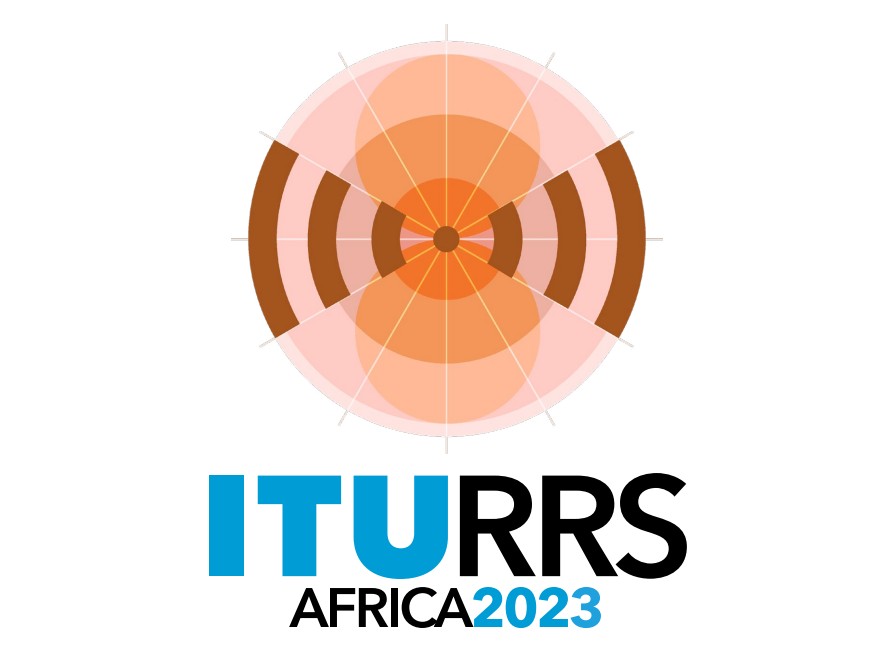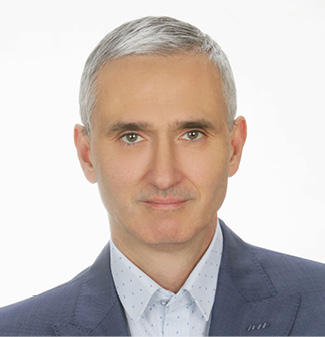
Tomasz Widomski, Co-founder, Elproma
The global economy depends on the global navigation satellite system (GNSS), which provides the coordinated universal time (UTC) reference to critical modern infrastructure worldwide.
This includes distributed smart grids, 5G telecom networks, traffic-control systems, and autonomous vehicles. It supports broadcasting services, financial markets, and smart cities, as well as Industry 4.0 systems migrated to the cloud.
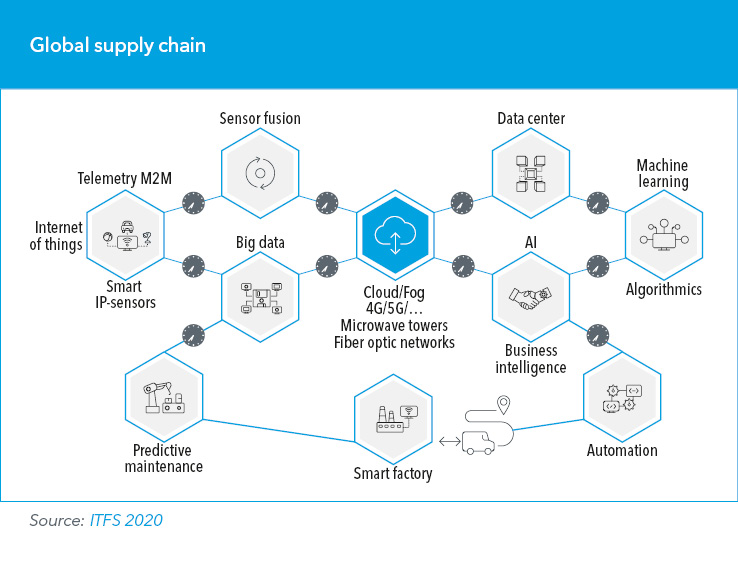
Leap-second challenges for Industry 4.0
The non-continuous nature of UTC, which requires periodically adding a leap second, affects all countries and all segments of every economy. It poses a particular problem for the stability and cybersecurity of Industry 4.0, the modern industries and services reliant on distributed system architecture.
Issues with the leap second have existed for years. But exponentially growing automation and the close interdependence of entire Industry 4.0 systems have given rise to a need for the urgent suspension of future leap seconds.
The situation is complicated by the lack of leap-second servicing standards, poor dialogue between the information technology (IT) and time metrology communities, the diversity of implementation for GNSS receivers, and the different approaches to service provision among global satellite navigation systems such as the Global Positioning System (GPS), Galileo, the Global Navigation Satellite System (GLONASS) and BeiDou, and regional systems like the Indian Regional Navigation Satellite System (IRNSS).
Disruption scenarios
The problems arising from adding leap seconds to UTC can include:
- Time discrepancies in distributed systems, where the validity of data is determined by the difference between timestamps for the remote sensor and the local receiving server of the centralized management. This can lead to the acceptance of invalid data (wrongly computed delay) and, consequently, to the wrong Industry 4.0 predictive maintenance. Such risks will increase with the growing adoption of time-sensitive networking (TSN), time-coordinated computing (TCC) and in future, low-latency networking.
- Failures of firmware software for Internet of things (IoT) and IT devices based on Windows, Linux, or Unix operating systems. Every sensor or appliance produced today has firmware based on one of those systems. The unexpected peaks in time introduced by the leap second are dangerous for the stability of the operating system kernel. They disturb the low-level event chronology that governs concurrency management and low-level system processes. Mismatches in chronology can result in “kernel panic” — a computer error from which an operating system cannot quickly or easily recover.
In such scenarios, the UTC leap second can trigger a large-scale domino effect, producing blackouts in power systems and telecommunications, as well as disrupting railways, air-traffic control, and Industry 4.0 process automation. Sooner or later, such failures will occur unless a leap second suspension is put into effect.
Industry risks
Today, we face the likelihood of a future leap second in UTC needing to be, for the first time in history, negative. In the working environment of Industry 4.0 production, this will be a dangerous experiment.
While the UTC leap second is the leading risk, it is not the only risk for Industry 4.0. Since the very first commercial GPS receiver was released in the 1990s, several hundreds of millions of commercial GNSS receivers have been deployed and used as UTC references. Yet they each calculate UTC a fraction of a second differently, due to variations in internal algorithms and depending on the current GNSS constellation they are using.
Accuracy in UTC synchronization also depends on weather conditions, quality of antenna installation, interferences, and cybersecurity, including GNSS jamming/spoofing. All these are further subject to the risk of internal GNSS errors (e.g., the GPS SVN23 13.5 microsecond (µs) error in January 2016) or overflows, such as the GPS week number rollover every 19.7 years.
Other GNSS constellations are similarly imperfect.
Synchronization for cybersecurity
Clearly, we need a security paradigm change, starting with a recognition of precise time synchronization as an important part of Industry 4.0 cybersecurity.
A good example is US Presidential Executive Order EO13905: Strengthening National Resilience Through Responsible Use of Positioning, Navigation, and Timing Services, released in February 2020. It opened the way for new low-Earth orbit (LEO) commercial satellite constellations. Crucially, it has also promoted computer-network synchronization protocols, such as the network time protocol (NTP) and precision time protocol (PTP) IEEE1588, both of which disseminate UTC from the national metrology institutes.
While the network time protocol was innately designed to use UTC, the precision time protocol can work with any time scale, including the coherent international atomic time (TAI) equivalent.
This article first appeared in ITU News Magazine: The future of Coordinated Universal Time – part of a series of editions on topics to be discussed at the World Radiocommunication Conference (WRC-23), from 20 November to 15 December in Dubai, UAE.
Download your copy of the ITU News Magazine: The future of Coordinated Universal Time.
Header image credit: Adobe Stock
By ITU News
The annual United Nations mid-year policy discussion on urgent global issues focused this year on “Accelerating the recovery from the coronavirus disease (COVID-19) and the full implementation of the 2030 Agenda for Sustainable Development at all levels.”
The High-level Political Forum on Sustainable Development (HLPF 2023) took place in New York between 10 and 19 July under the auspices of the UN Economic and Social Council (ECOSOC). More than ever before, discussions underlined the need for digital solutions to meet climate, education, energy, and human rights goals, as well as to drive sustainable agriculture, industrialization, and tourism.
The International Telecommunication Union (ITU), as the UN tech agency, addressed several sessions, with ITU Secretary-General Doreen Bogdan Martin contributing an official statement and ITU delegations addressing meetings organized by other UN organizations and partners.
“In a world where 95 percent of the global population is within range of a mobile broadband network, mere connectivity is not sufficient,” observed ITU Secretary-General Doreen Bogdan-Martin. “Too many people who could go online decide against it because they do not have the digital skills — or because the experience is not safe, beneficial, or affordable.”
UN agencies increasingly recognize the need for a digital perspective to achieve each of the 17 Sustainable Development Goals.
Digital solutions for sustainable development
The UN Department of Economic and Social Affairs (UN DESA) worked closely with ITU in organizing expert meetings on industry, innovation, and infrastructure (SDG 9) and sustainable cities and communities (SDG 11).
In SDG 9 discussions, ITU emphasized the need for meaningful connectivity, and for continuous collaboration between governments, the private sector, and civil society, to drive digital transformation and bridge the global digital divide.
During the 10-day forum, ITU hosted side events on universal and meaningful connectivity, the metaverse and cities, and the ongoing Action Lines of the World Summit on the Information Society (WSIS).
The ITU delegation spoke on 17 July about accelerating achievement of the SDGs and climate action through digital public infrastructure and digital public goods.
HLPF 2023 saw the release of two new reports from the UN Secretary-General:
Both reports highlight the impacts of digitalization and emerging technologies on the achievement of the SDGs and COVID-19 recovery.
ITU and the United Nations Development Programme (UNDP) with knowledge partner Boston Consulting Group will bring together partners from the UN system and beyond on 17 September for SDG Digital, putting data and digital technologies front and centre to catalyse action on all 17 of the UN’s global goals.
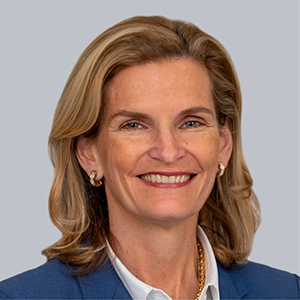
Doreen Bogdan-Martin, ITU Secretary-General
Terrestrial communications and digital transformation go hand in hand. Whether on land, at sea, or up to 50 kilometres above our heads, terrestrial radio services have helped connect countless communities across the globe, empowering them with opportunities to thrive now and into the future.
As we strive together to connect the remaining 2.7 billion amid a shifting technological landscape, terrestrial radio remains a key part of the equation.
From mobile broadband access through high-altitude platforms to the lifesaving disaster alerts at the heart of the Early Warnings for All Initiative, terrestrial radio can help us reach the remotest corners of our planet, build digital resilience worldwide, and ensure that technology’s transformative potential is shared sustainably and equitably.
All of this and more will be discussed at the World Radiocommunication Conference (WRC‑23) in November and December in Dubai, UAE. The conference’s crucial updates to the Radio Regulations will help ensure current services can continue, while enabling the seamless integration of ground-breaking new technologies and applications.
This is an exciting time to be in terrestrial services.
Let’s use this moment to build a safe and sustainable digital future for all.
Download your copy of the ITU News Magazine: Land, sea and airwaves.
Header image credit: Adobe Stock
Photo: ITU/D. Woldu
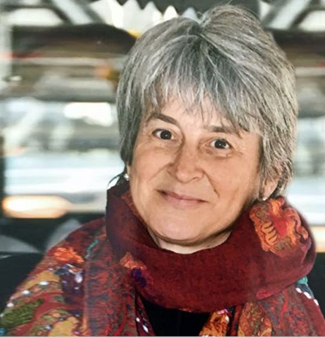
Patrizia Tavella, Director, Time Department, BIPM
Coordinated Universal Time (UTC) is the worldwide reference time scale computed by the Bureau international des poids et mesures (BIPM) − the international organization dealing with matters related to measurement science and measurement standards.
UTC is based on about 450 atomic clocks, which are maintained in 85 national time laboratories around the world.
The clocks provide regular measurement data to BIPM, as well as the local real-time approximations of UTC, known as UTC(k), for national use (see figure).
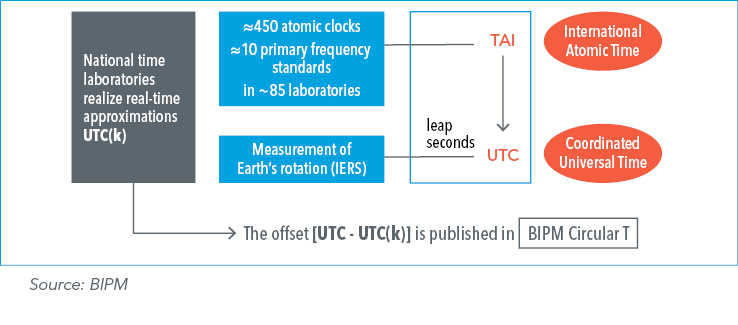
The scale unit, the second, and the reference time scale UTC are defined and realized under the authority of the General Conference on Weights and Measures (CGPM), where 64 Member States and 36 Associate States and economies are represented.
The International Earth Rotation and Reference Systems Service (IERS) determines and publishes the difference between UTC and the Earth rotation angle indicated by UT1. Whenever this difference approaches 0.9 seconds, a new leap second is announced and applied in all time laboratories.
UTC and the UT1‑UTC difference are transmitted by several time and frequency services regulated by the ITU Radiocommunication Sector (ITU–R — one of three Sectors of the International Telecommunication Union).
How BIPM obtains UTC
BIPM first computes a weighted average of all the designated atomic clocks to achieve International Atomic Time (TAI). The algorithm for computing TAI is complex, involving estimation, prediction and validation for each type of clock.
Similarly, measurements to compare clocks at distance are based either on global navigation satellite systems (GNSS) or on other techniques, such as two-way satellite time and frequency transfer, or via optical fibres. These all need to be processed to compensate for the delay due, for example, to the ionosphere, the gravitational field, or the movement of satellites.
Ultimately, UTC is obtained from TAI by adding or removing a leap second as necessary and maintaining the same ticking of the atomic second.
UTC’s alignment with Earth’s irregular rotation
In the 1970s, at the beginning of the atomic clock era, it was agreed that UTC be kept in alignment with the irregular rotation of the Earth, as UTC allowed an estimation of the Earth rotational angle UT1 with a 0.9 second tolerance. This was largely required for navigation systems based on celestial observations. At the outset, UTC was corrected in very small time and frequency steps. From 1972 onward, entire leap seconds were used (see figure).
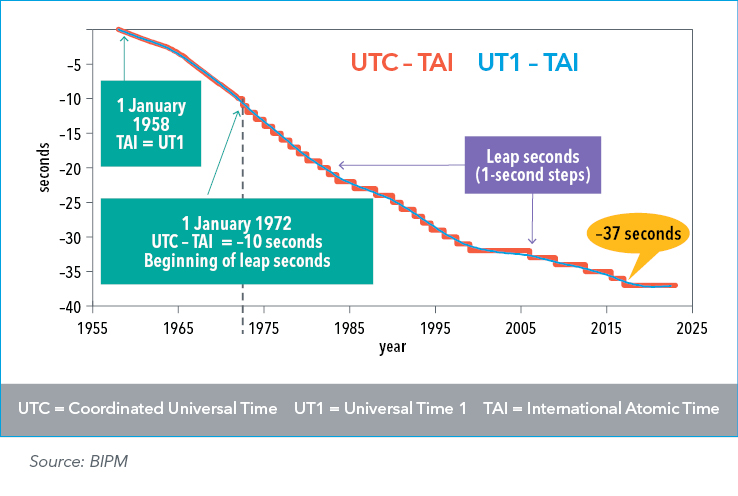
Tech companies using leap-second alternatives
The application of the leap second follows the sequence of second labelling as shown below. An inserted leap second is labelled as 23:59:60 — a clock-time unforeseen in most modern, digital systems.
This discrepancy caused the proliferation of ad hoc methods that are increasingly being used as alternatives to the leap second.
Google for example “smears” the additional second over the previous 24 hours, Facebook over the subsequent 18 hours, Microsoft over the last two seconds, and Alibaba over an interval of 24 hours centred on the leap second.
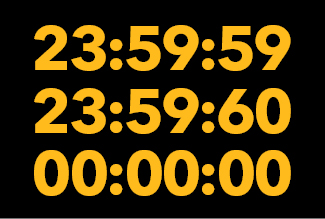
Risks associated with leap seconds
From the perspective of managing complex systems, the application of the leap second on all satellite clocks at the same instant is a risk. This is why most global navigation satellite systems (excluding GLONASS) opted to synchronize their clocks and time scale with UTC at the outset, without adding any leap seconds.
Today, consequently, GPS time is ahead of UTC by 18 seconds. The same applies for Galileo time, while BeiDou time is ahead by four seconds (see figure).
This situation causes confusion among users on the day a leap second is applied. It also gives rise to concerns about the risk of anomalies that could undermine the reliability of critical national infrastructure.
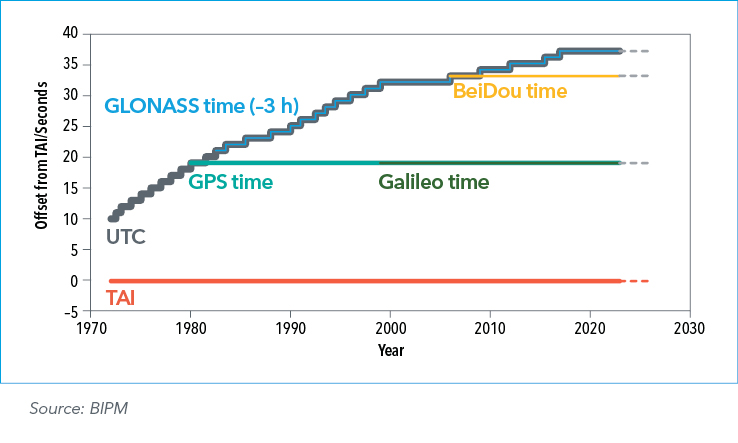
Keeping UTC in alignment with Earth’s rotation
The 27th meeting of the General Conference on Weights and Measures, held in November 2022, decided to maintain the existing process to keep UTC in alignment with the Earth’s rotation. The decision, however, envisages a larger tolerance limit than nine tenths of a second — with correspondingly larger but less frequently needed adjustments — to guarantee UTC’s continuity for at least the next 100 years.
BIPM is currently working with ITU–R and other organizations on a new process, expected to come into force in 2035. This would include a newly identified tolerance value for the UT1‑UTC offset, to ensure UTC remains efficient and effective in serving current and future timing applications.
This article first appeared in ITU News Magazine: The future of Coordinated Universal Time – part of a series of editions on topics to be discussed at the World Radiocommunication Conference (WRC-23), from 20 November to 15 December in Dubai, UAE.
Download your copy of the ITU News Magazine: The future of Coordinated Universal Time.
Header image credit: Adobe Stock
ITU News
A new United Nations initiative announced at the AI for Good Global Summit focuses on scaling up artificial intelligence (AI) solutions for health.
The Global Initiative on AI for Health is spearheaded by the International Telecommunication Union (ITU), the World Health Organization (WHO), and the World Intellectual Property Organization (WIPO).
The three UN specialized agencies have joined forces to ensure that AI fulfils its potential to support diagnosis and treatment, along with more efficient and inclusive healthcare services.
“AI is already playing a role in diagnosis and clinical care, drug development, disease surveillance, outbreak response, and health systems management,” said WHO Director-General Dr Tedros Adhanom Ghebreyesus in his address to the ITU-led summit.
“The future of healthcare is digital, and we must do what we can to promote universal access to these innovations and prevent them from becoming another driver for inequity,” he emphasized.
Dr Ghebreyesus posted a video of his remarks at the #AIforGood Summit on Twitter. Play the video.
Building on five years of momentum
The global initiative aims to develop technical standards and policy guidance, facilitate knowledge and data sharing, and support evidence-based decisions on the introduction of AI solutions for health.
The initiative builds on the momentum created by the ITU-WHO Focus Group on AI for Health established in 2018.
The focus group has studied AI solutions in 24 topic areas, ranging from neurology and radiology to dermatology and outbreak detection. Its open-code programme has enabled experts from around the world to collaborate on the development and benchmarking of innovative AI solutions for health.
The group has also delivered important guidance on AI governance in the health domain, including on ethics, regulatory considerations, data quality, and the clinical evaluation of AI solutions.

Earning the trust of healthcare professionals
The ongoing UN inter-agency cooperation recognizes a growing need to certify trustworthy AI health solutions.
The focus group has developed a benchmarking framework for audits and clinical evaluations of new AI solutions.
The open-code Proof of Concept for the benchmarking platform showcases the kinds of metrics that could help technology developers and health regulators to certify AI solutions, just as they do other medical equipment.
“Interventions at this year’s Assemblies of the Member States of WIPO highlighted the intense and growing interest in AI and intellectual property, particularly its role in addressing global challenges,” said WIPO Assistant Director General Edward Kwakwa.
“AI and intellectual property, including their data dimensions, are a key part of the discussion on AI for health and, more broadly, AI for sustainable development,” he noted. “WIPO hosts a regular Conversation on AI and frontier technologies. Our next Conversation on September 21 to 22 will be on intellectual property and generative AI technologies.”
Benefiting everyone, everywhere
The new initiative looks to expand on AI-for-health achievements and drive their global implementation.
Key objectives include:
- Developing governance frameworks, technical standards, associated open-code tools, and guidelines for AI to contribute to universal health coverage.
- Promoting cooperation on knowledge and data sharing, and developing collaborative funding mechanisms for AI solutions to reach underserved communities.
- A scaling programme to assist low- and middle-income countries in adopting AI solutions for health, initially working with between 12 and 18 countries.
ITU’s AI for Good platform brings 41 UN agencies together with a diverse array of innovators and industry partners, aligning AI, machine learning and robotics with the UN Sustainable Development Goals.
ITU Secretary-General Doreen Bogdan-Martin noted how cooperation on AI for health could help shape appropriate AI governance frameworks, ensuring technology works in the best interest of humanity.
“Alongside technical leaps in domain-specific fields like radiology, cardiology, and dermatology, our focus group has made huge strides in AI governance, from ethical data acquisition to accessibility and clinical evaluation,” she said.
“As we transition from the focus group to the Global Initiative on AI for Health, we are very excited to see how we can take data standards further, to ensure AI continues expanding and evolving as a vital part of inclusive healthcare.” To join the initiative, contact tsbfgai4h@itu.int.
Header image credit: Adobe Stock
Photo: ©ITU/D.Woldu
By Atsuko Okuda, Director, ITU Regional Office for Asia and the Pacific
Gokina is an idyllic-looking village located 25 kilometers from Pakistan’s capital city. Our car ride there took us uphill on winding roads into the verdant mountains overlooking Islamabad. Goats greeted us as we walked down the steep, narrow path to the village school.
The village hosts a pilot Smart Villages project – the first Smart Village of the International Telecommunication Union (ITU) in the Asia-Pacific region. It is part of ITU’s Smart Villages and Smart Islands (SVSI) initiative, first launched in Niger in 2020 and subsequently adopted and adapted for Asia and the Pacific as a means of connecting unconnected people and communities by 2030.
Cosmas Luckyson Zavazava, Director of the ITU’s Telecommunication Development Bureau, has highlighted the key role of the initiative, emphasizing: “The strategy behind this is smart.”
Projects like the one in Gokina directly address key priorities set out during the World Telecommunication Development Conference (WTDC) last June in Kigali, Rwanda.
“It helps us implement the Kigali Action Plan, deliver tangible results for people, and make government services more accessible and financial inclusion possible,” Dr Zavazava adds. “Overall, it brings countries closer to meaningful connectivity and sustainable digital transformation.”
The Smart Villages initiative in Pakistan is supported by Huawei, ITU, the Federal Ministry of Information Technology and Telecommunication (MoITT), Universal Service Fund (USF Pakistan), social enterprise TeleTaleem, and one-stop telemedicine provider Sehat Kahani.
Pakistan’s Federal Minister of Information Technology and Telecommunication, H.E. Syed Amin Ul-Haque, launched the country-level initiative in Gokina earlier this year, on 23 February.
Local digital dividends
At the Islamabad Model School for Girls in Gokina, some students were learning online about global warming, while others were studying Urdu grammar.
Asked about the benefits of such e-learning, the girls all expressed excitement about connectivity and the expansion of their learning opportunities through the Smart Villages initiative.
Shaiza, a 9th Grade student at the school, said: “I am very happy to learn science subjects through the online classes that are now offered due to these smart classrooms. We never had this opportunity in the past.”
Similarly, at the local health clinic, we witnessed how medical consultations were being conducted via newly acquired connectivity.
Rania, a nurse at the new Sehat Kahani telemedicine clinic said: “Sehat Kahani and the Smart Village have filled a big gap in access to health services in Gokina. Before the establishment of this clinic, these patients had to travel long distances for healthcare services and medicines, resulting in the further deterioration of their conditions. Now, having an e-clinic within the community, with online access to doctors, these patients are getting quick and accessible health services.”
A new, more holistic approach
Technologies have kept evolving, with high-speed network rollouts now being coupled with wider usage of artificial intelligence (AI), blockchain, the Internet of Things (IoT) and data analytics. All the while, digital policy and financial instruments, such as universal service funds, have matured.
But if we don’t connect the world’s 2.7 billion unconnected people soon, rapid digital transformation will bypass them.
Industry, fortunately, is keen to support efforts to widen meaningful digital access and, more broadly, help achieve the United Nations Sustainable Development Goals.
Before launching the SVSI initiative, ITU consulted with academia, industry and organizations that had previously implemented telecentre and community networks, including the Internet Society. Through those global and regional queries, we came to believe that the answers lay in a qualitative transformation in design and implementation, particularly based on the whole-of-government and whole-of-society approach.
If we step up collaboration and move away from sectoral and partnership siloes, we should be able to pool enough resources and expertise to sustain such efforts and respond to the priorities of communities. The more evidence-based and partnership-enabled the better.
Partnerships for digital services
Could initiatives like Smart Villages and Smart Islands serve as a platform for partners and line ministries to launch digital services? This could include digital education, health, and agriculture, combined with affordable devices, digital skills training, and community engagement.
To put the necessary conditions in place, Pakistan’s MoITT formed a steering committee to advise on Smart Villages design and implementation. We hope to see more partners and ministries joining this steering committee to create synergies and efficiencies across rural connectivity initiatives in Pakistan.
The Digital Inclusion Week organized by MoITT last December highlighted ITU’s work on Girls in ICT (information and communication technology), Child Online Protection, and ICT for persons with disabilities.
Building on the momentum, MoITT is setting up three working groups and inviting interested academia and industry partners to join the discussions, which are sure to enhance community engagement and digital skills training for Smart Villages in Gokina and beyond.
Building back better
Across Asia and the Pacific, the lockdowns and restrictions related to the COVID-19 pandemic propelled digital connectivity into rural areas.
According to ITU’s Facts and Figures 2022, the number of Internet users worldwide increased from 4.2 billion in 2019 to 5.3 billion in 2022.
But of the 2.7 billion still offline, the vast majority live in developing countries, often in rural and remote communities like in Gokina.
Momentum is building to connect them, with partnerships are expanding through innovative initiatives like Smart Villages and Smart Islands.
Inspired by what I saw in Gokina, I remain cautiously optimistic that we can make the necessary strides in connecting the unconnected, leaving no one behind or offline by 2030.
Header image credit: ITU
Experts and officials from ITU’s Africa Region discussed ways to enhance digital connectivity using broadband wireless and satellite technologies
The African telecommunications industry is calling for greater investment in wireless broadband and satellite technologies on the continent to expand access to affordable and sustainable digital connectivity.
Regulators, industry experts, and academia met during the ITU Regional Radiocommunication Seminar for Africa (RRS-23-Africa) and reiterated the critical need for digital technologies to enable sustainable development for Africa.
The seminar, held in Brazzaville, Republic of Congo, on 20-23 June, was organized by the International Telecommunication Union (ITU) in collaboration with the Policy and Regulation Initiative for Digital Africa (PRIDA) and hosted by the Republic of the Congo’s Postal and Electronic Communications Regulatory Agency (ARPCE) in cooperation with the African Telecommunications Union (ATU).
The seminar discussed Africa’s future radio-frequency spectrum requirements in the context of revisions made to the Radio Regulations by the last World Radiocommunication Conference (WRC-19), held in Sharm-el-Sheikh, Egypt, in 2019.
Spectrum requirements are continually reviewed at the regional level to keep up with new technologies and changing demand.
“Efficient spectrum management is key to enabling universal connectivity in Africa,” said Léon Juste Ibombo, Minister of Postal Services, Telecommunications, and the Digital Economy in the host country. “Countries in the region need to keep working together towards a common approach that will meet the region’s spectrum needs. Africa looks forward to successful negotiations at the upcoming WRC-23 in Dubai, UAE.”
Fundamental for expanding connectivity
Participants in the regional seminar reviewed key aspects of spectrum management at the national and international levels in relation to the ITU Radio Regulations, the international treaty governing the global use of radio-frequency spectrum and satellite orbits.
They also addressed procedures for submitting frequency assignments to the International Frequency Information Exchange (IFIE) database; the current regulatory framework for international frequency management; ITU Radiocommunication (ITU-R) Recommendations; and best practices for spectrum use by both terrestrial and space services.
Mario Maniewicz, Director of the ITU Radiocommunication Bureau, called efficient management of radio-frequency spectrum a prerequisite for countries to achieve affordable connectivity for everyone in Africa.
“The regional seminar series is a key component of our capacity-building program to strengthen national and regional policies and ensure better use of the radio spectrum,” he added. “These meetings enable the administrations of ITU Member States, as well as companies and organizations that are engaged with us as sector members, to familiarize themselves with key tools and documents for efficient, forward-looking spectrum management.”
Participants reviewed updates to the Radio Regulations (2020 Edition), including results of WRC-19, as well as the agenda for WRC-23 in Dubai this November and December.
Regulators and industry stakeholders exchanged ideas on which agenda items had the greatest regional-level implications for Africa.
The seminar also examined international spectrum harmonization and the procedures for recording frequency assignments in the Master International Frequency Register (MIFR).
A workshop portion included training on tools developed by ITU for frequency notices and technical examinations. Through various tutorials, participants gained experience with ITU notification procedures, as well as with the software and electronic publications that the Radiocommunication Bureau provides for ITU Member States and ITU-R sector members.
RRS-23 for Africa concluded with a “Wireless Broadband: Terrestrial and Space” workshop, in which industry representatives discussed how wireless broadband and satellite services can help bridge the digital divide in Africa with affordable and sustainable connectivity.
Clarifying regional spectrum priorities
ITU Regional Radiocommunication Seminars aim to assist ITU Member States, particularly developing countries, in spectrum management activities and the application of the ITU Radio Regulations and relevant ITU-R publications.
The seminars are also key to enabling ITU Member States to make use of ITU-provided tools and resources in formulating their national and regional policies on the use of the radio spectrum.
The seminars complement the biennial World Radiocommunication Seminars, helping countries and regions to fully understand and implement the Radio Regulations. Part of a four-year conference cycle, the regional discussions particularly illuminate the treaty’s most recently adopted provisions, enabling all countries and regions to prepare over the four-year cycle for the next World Radiocommunication Conference.
Learn more:
To celebrate International Moon Day, the head of ITU’s expert group for space radiocommunication applications reflects on the new age of lunar exploration.
By Cathy Sham, NASA Lunar & Human Spaceflight Spectrum Manager; Chair of ITU-R Working Party 7B
US space agency NASA – the National Aeronautics and Space Administration – recently launched its most powerful rocket ever. On 16 November, Artemis I was propelled into Earth’s orbit by the new Space Launch System (SLS) rocket, carrying the unmanned Orion spacecraft on its maiden mission to the Moon.
Orion reached the Moon, flew 130 kilometres above the lunar surface, and travelled over 2.25 million kilometres during its three-week journey. The craft then re-entered Earth’s atmosphere and splashed down safely in the Pacific Ocean.
These successes of Artemis I have established the space-worthiness of the SLS and Orion. Now, NASA and international partners – including the Canadian Space Agency (CSA), the European Space Agency (ESA), and the Japan Aerospace Exploration Agency (JAXA) – are firmly on a path to usher in a new era of long-term human presence in, on and around the Moon by the end of the decade.
Artemis II will send the first person of colour and the first woman to the Moon, ushering in a new era of human spaceflight. Then, Artemis III will land the first humans on the lunar surface in over 50 years.
As these missions develop, NASA aims to work even more closely with other space agencies and with industry partners to ensure maximum benefits for everyone. Many space agencies that are similarly interested in lunar exploration have recognized the value of early cooperation and coordination, particularly since 2021 through the Space Frequency Coordination Group (SFCG).
The Artemis Accords, with more than 25 signatories to date, are rooted in principles established in the Outer Space Treaty of 1967. Accordingly, they lay out a shared vision of cooperation in the civil exploration and use of the Moon.
This means facilitating lunar exploration, science, and commercial activities for all of humanity to enjoy.
Under the Artemis campaign, NASA and other space agencies are developing spacecraft, surface vehicles, and robotic systems, as well as designing unique scientific experiments to further enhance our understanding of the Universe together.
The aim is to establish a sustainable and robust presence on the Moon in the next decade.
Just like in the Apollo era over half a century ago, innovations envisaged to support a sustained human presence on the Moon could also stimulate breakthroughs that improve life here on Earth.
The United Nations Office for Outer Space Affairs (UNOOSA) has identified numerous ways space exploration can help meet UN Sustainable Development Goals.
Spectrum management on and around the Moon
Lunar exploration was the exclusive domain of government-run space agencies since the 1960s. But this is no longer the case in the Artemis era. Commercially owned and operated landers and rovers are about to arrive, with around 10 such missions expected to land on the lunar surface by the end of 2023.
The companies behind these missions – looking beyond the science traditionally carried out by governmental agencies – are interested in the Moon’s economic potential.
While NASA envisages a sustained lunar presence for science and exploration purposes, other lunar stakeholders are planning robotic mining, radio astronomy, and even tourism ventures.
Mission planners, engineers, scientists, architects, and regulatory experts must work together to ensure adequate radio spectrum access for all users. The demand is growing on, and for, radio frequencies that can be used to send commands to spacecraft, receive mission and health data, and accurately locate resources, systems, and astronauts.

Image: NASA
Cooperation on radio frequency allocations
Starting in 1997, the International Telecommunication Union (ITU) has urged countries to consider the implications of establishing a lunar communications relay system. ITU’s Radiocommunication Assembly posed several questions on frequency bands, bandwidth, orbital requirements, and other operational and technical requirements, along with considerations about sharing with other services.
The ITU Radiocommunication Sector (ITU-R) adopted a new study question in 2022 seeking ways to maintain the protection of radio astronomy services in the Shielded Zone of the Moon (SZM) while considering the critical and essential communications links for system control and data collection.
As radio astronomers develop more detailed plans, the technical and operational characteristics of radio astronomical observation in the SZM, including which frequency bands can be expected to maximize the scientific output, are becoming clearer. Scientists and engineers are also starting to develop ideas about support systems, such as communications platforms to transmit data back to scientists on Earth.
Peaceful relations and orderly international cooperation over space radiocommunication allocations are essential, whether for multinational or commercial missions.
The upcoming 2023 World Radiocommunication Conference (WRC-23) will bring together national administrations, space agencies, and a wide array of technical experts to review and update the ITU’s Radio Regulations. Administrations will also consider topics for the next edition (WRC-27) around four years from now.
Among the many topics, the Report to the Conference by ITU’s Radiocommunication Director invites consideration of determining whether a new requirement should be added in the Radio Regulations to ensure compliance with Regulation Nos. 22.22 to 22.25 on radio astronomy in the SZM.
Additionally, space agencies have come together to support a WRC-27 proposal to study the feasibility of allocations for space research, in order to lay the foundation for successful lunar missions in the decades to come.
NASA and its fellow space agencies envisage continued research to improve human lives and satisfy the human quest for knowledge of our universe. The exploration missions that support such research would not be possible without ITU’s work, which ensures that the valuable resource of the radio spectrum is used in the most effective and efficient manner.
Header image credit: NASA
ITU News
The tech industry is notoriously male dominated.
Today, women still account for only 30 per cent of science and technology professionals worldwide.
Historically, similar patterns held true at the International Telecommunication Union (ITU), the 158-year-old steward of global connectivity that 76 years ago became one of the specialized agencies of the United Nations.
But a quarter of a century ago, ITU’s Member States – representing nearly every country in the world – resolved to change the pattern and strive pro-actively for gender equality. Resolution 70, adopted by the organization’s 1998 Plenipotentiary Conference, affirms their commitment to include a gender perspective in all ITU work and activities.
Since then, women have achieved leadership positions in nearly every part of the organization. A woman became ITU Secretary-General for the first time in January 2023.
25 years of women stepping up
A few key trailblazers stand out in the timeline of women stepping up at ITU:
- Lyndall Shope-Mafole (South Africa) was the first women to chair the ITU Council, taking the role on in 1999, just a year after the key gender mainstreaming resolution.
- Audrey Loridan-Baudrier (France) was ITU’s first woman Study Group Chair, achieving the key post with the expert group on strategies and policies in ITU’s Development Sector (ITU-D Study Group 1) in 2002.
- In 2003, Dr Veena Rawat (Canada) chaired World Radiocommunication Conference (WRC) and took the helm at the ITU Radiocommunication Sector group studying satellite services (ITU-R Study Group 1).
- Marie-Thérèse Alajouanine (France) became the first woman Study Group Chair in the ITU Standardization Sector (ITU-T), heading the group for operational aspects of service provision, networks, and performance (ITU-T Study Group 2) starting in 2005.
- In another first for women, Dr Hessa Al Jaber (Qatar) chaired ITU’s World Telecommunication Development Conference (WTDC) in 2006.
- In 2008, Julie Napier Zoller (US) became the first woman to chair the key Radio Regulations Board.
- Roxanne McElvane Webber (US) became chair of ITU’s Telecommunication Development Advisory Group in 2018.
In the last five years, ITU has managed to crack – though not yet shatter – the glass ceiling.
As gender equality continued gaining traction across the UN system, ITU’s Member States chose the first women for any of the specialized agency’s five elected leadership posts. Doreen Bogdan-Martin (US) was first elected as Director of the Telecommunication Development Bureau in 2018 and then as ITU Secretary-General in 2022.
Where we are now
Still, just like in the tech sector at large, women remain underrepresented at ITU – especially in more senior roles.
The organization, however, is committed to raising awareness and challenging biases through gender campaigns and training. In all areas of its work, ITU encourages dialogue and discussion on gender equality, diversity, and inclusion.
Explore gender statistics for:
Resolution 70 remains ITU’s guiding decision on gender equality. ITU’s governing body meetings are now consciously gender-responsive, with Member States being urged to nominate more women to leadership positions until each part of the organization achieves approximate gender parity.
Header image credit: ITU/D. Woldu
ITU News
A new global challenge promoting artificial intelligence (AI) for water, agriculture and energy sustainability welcomes your participation as part of a drive for digital solutions addressing the climate crisis.
The AI/ML Solutions for Climate Change challenge involves problem-solving competitions set to culminate at the United Nations climate change conference, COP28.
The latest in a series of AI for Good challenges organized by the International Telecommunication Union (ITU), it aims to enhance a broad partnership drive for Green Digital Action at COP28.
Registration for the new climate action challenge is open until 30 September 2023.
The move to crowdsource innovative AI solutions is supported by ITU, the International Atomic Energy Agency (IAEA), the UN Food and Agriculture Organization (FAO), the UN Educational, Scientific and Cultural Organization (UNESCO), and the World Bank.
Collaborative problem-solving
The climate action challenge aims to create an innovation ecosystem where collaborative problem-solving will help bring promising AI solutions to global scale.
It will connect participating innovators with new partners in industry and academia – as well as new tools and data resources – to compete in problem-solving competitions with support from mentors and in-depth tutorials.
Participating AI developers will be able to showcase and hone their skills, gain global recognition, and rally support for their innovations.
A series of AI for Good webinars will highlight the competition in the run-up to COP28, where winning solutions will be pitched to a global audience and the overall winner will be announced.
The new climate action challenge is modelled on successful ITU challenges to apply AI and machine learning in 5G networks and geospatial data analysis. These problem-solving competitions, first launched in 2020, have given rise to valuable AI solutions and helped build AI innovation capacity around the world.
Water, agriculture, and energy
The climate action challenge hosts six competitions under three broad themes:
Water resource management
- AI solutions to detect climate extremes, forecast flood and droughts to provide early warnings, and identify water resources vulnerable to climate change and define optimal adaptation pathways.
Curated by UNESCO
- Integrating AI in isotope hydrology studies, with a view to reconstructing temporal and spatial isotopic variability and creating data snapshots that improve our understanding of climate change patterns, enable paleoclimate reconstruction, and reinforce hydrological and climate models.
Curated by IAEA
The competitions are facilitated by a stream of the AI for Good Innovation Factory led by ITU and IAEA.
Food and climate-smart agriculture
- AI solutions complementing Earth Map – a free open-source tool developed under the FAO-Google partnership – to help users identify water-related challenges in specific areas of interest, leveraging the datasets and functionalities available within Earth Map.
Curated by FAO
- AI-driven area mapping and estimations of area-wide soil properties, based on fusing data at different resolutions (for example, from point to landscape data) and collection methods such as infrared spectroscopy, gamma spectrometry, and satellite imagery.
Curated by Joint FAO/IAEA Centre
- AI-based techniques for cosmic-ray neutron sensing and gamma spectrometry in combination with satellite imagery for area-wide monitoring and mapping of soil moisture, which can also address crop productivity and provide early warnings of floods or droughts.
Curated by Joint FAO/IAEA Centre
The competitions are facilitated by a stream of the AI for Good Innovation Factory led by ITU and IAEA.
Reducing the energy consumption of 5G networks
- AI solutions for network operators to curb their energy consumption, said to account for as much as 90 per cent of their operational expenditure on their networks. Estimates suggest that 5G networks are around four times more energy-efficient than 4G networks, but that total energy consumption is approximately three times larger as result of 5G’s need for higher densities of networking equipment.
Curated by Huawei
The competition is facilitated by the ITU AI/ML in 5G Challenge.
Header image credit: Adobe Stock/NASA
